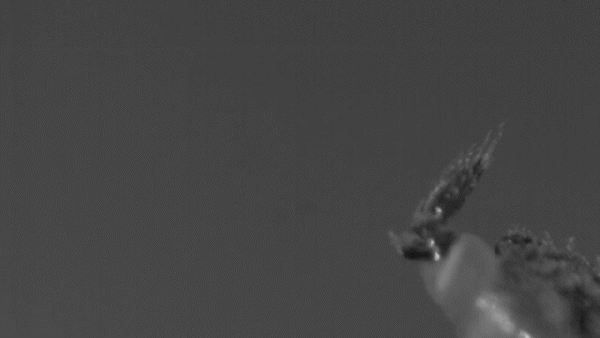Natural Sciences
Why Newborn Chicks Love Objects That Defy Gravity
A clever new study shows the cute critters will often scuttle toward a video of a rising ball
Rare Jurassic-Era Insect Discovered at Arkansas Walmart
The species had not been recorded in eastern North America for more than 50 years—and never documented in the state
These Tiny Bugs Urinate by Flinging Droplets of Pee
Sharpshooters are the first example of “superpropulsion” in a living organism, according to new research
Twenty-Three Smithsonian Shows to See in 2023
A rare Bible, George Clinton's colorful wig, Disney World history and Japanese ghosts debut this year
Human Ancestors May Have Evolved to Walk Upright in Trees
Research on wild chimpanzees suggests searching for food in tree branches drove bipedalism
Charles Darwin's Rare Autographed Manuscript Could Sell for $800,000
The English naturalist was responding to a magazine editor who had asked for a handwriting sample
Adélie Penguins Are Dwindling in East Antarctica
Researchers blame too much summer sea ice for causing a downward spiral in one colony
These California Teens Discovered Two New Scorpion Species
One of the creatures could be wiped out if its range isn't protected, researchers say
Dogs May Have Evolved From Two Different Wolf Populations
A massive new wolf family tree dating back 100,000 years could help researchers understand where dogs were first domesticated
What Causes Swaths of the Ocean to Glow a Magnificent Milky Green?
A sailor who witnessed the rare phenomenon in person and a scientist who saw it from the sky team up to learn about the ghostly light
An Extinct, Head-Butting Animal May Help Explain Giraffes' Long Necks
The giraffe’s ancestor used its sturdy head and neck to fight for mates
First U.S. Open-Air Test of Genetically Modified Mosquitoes Deemed a Success
Biotech firm Oxitec engineered the bugs in an effort to curb their numbers and help stop the spread of disease
Five Big Changes Scientists Have Documented During Yellowstone National Park's 150-Year History
Scientists have monitored the region closely for generations, and these are some of the most dramatic shifts they've seen
Fourteen Ways That Spiders Use Their Silk
From making parachutes to building scuba tanks, the arachnids have come up with some fascinating creations
Inside the Growing Movement to Share Science Through Quilting
The classic medium allows researchers, students and artists to tell stories about science, technology, engineering and math
Historians Identify 14 Living Relatives of Leonardo da Vinci
An ongoing effort to trace the artist's male lineage may help researchers sequence his genome
New Species of Beetle Found in 230-Million-Year-Old Feces
The insect is older than any amber-encased specimen, and may inspire scientists to look for more insects in fossilized dung
Can Climate Fiction Writers Reach People in Ways That Scientists Can't?
A new subgenre of science fiction leans on the expertise of biologists and ecologists to imagine a scientifically plausible future Earth
Rare Owl With Bright Orange Eyes Seen for the First Time in More Than 125 Years
The elusive Bornean Rajah scops owl is inspiring scientists and researchers after its brief rediscovery
How Opera Singing Is Helping Long-Haul Covid-19 Patients Recover
Developed in the United Kingdom, ENO Breathe is a virtual program that rehabilitates patients through the art of song
:focal(800x602:801x603)/https://tf-cmsv2-smithsonianmag-media.s3.amazonaws.com/filer_public/57/cd/57cd6da5-e1c6-4b8d-988c-d30d2a2b3ff8/gettyimages-931846248_web.jpg)
:focal(500x224:501x225)/https://tf-cmsv2-smithsonianmag-media.s3.amazonaws.com/filer_public/4f/5d/4f5d0579-4168-42e1-8061-be59b306043e/lacewing-main.jpeg)

:focal(800x602:801x603)/https://tf-cmsv2-smithsonianmag-media.s3.amazonaws.com/filer_public/e0/ce/e0ce60db-7ee1-494a-80af-84eb98ac1c0a/coverimage.jpg)
:focal(591x366:592x367)/https://tf-cmsv2-smithsonianmag-media.s3.amazonaws.com/filer_public/0b/90/0b9015cd-2dcd-4d42-ad37-2b584187050b/imba_180920.png)
:focal(2160x1440:2161x1441)/https://tf-cmsv2-smithsonianmag-media.s3.amazonaws.com/filer_public/00/44/004485d0-cb08-40b2-a8b8-621831cf7547/092322-mfm-darwin-004_1.jpg)
:focal(600x400:601x401)/https://tf-cmsv2-smithsonianmag-media.s3.amazonaws.com/filer_public/ad/02/ad028fdc-8479-4d33-8e7e-e8d65823ffa0/dsc_05311200x0.jpg)
:focal(480x272:481x273)/https://tf-cmsv2-smithsonianmag-media.s3.amazonaws.com/filer_public/8e/20/8e2094e5-f0eb-49e2-94f2-802a3b00d344/paruroctonus_soda.jpeg)
:focal(960x571:961x572)/https://tf-cmsv2-smithsonianmag-media.s3.amazonaws.com/filer_public/79/a1/79a14d0e-b44f-42be-aa1a-50a47b24f96e/wolf-2984865_1920.jpg)
:focal(800x602:801x603)/https://tf-cmsv2-smithsonianmag-media.s3.amazonaws.com/filer_public/aa/04/aa04fd91-aabf-480d-a811-fe96a89464ee/header-milky-seas_web.jpg)
:focal(960x640:961x641)/https://tf-cmsv2-smithsonianmag-media.s3.amazonaws.com/filer_public/ae/7a/ae7a30bc-1732-4ddf-b0cf-b1833924aa01/giraffe-5799824_1920.jpg)
:focal(350x235:351x236)/https://tf-cmsv2-smithsonianmag-media.s3.amazonaws.com/filer_public/d5/a3/d5a3ae2e-0e79-4b35-bc93-3b0a8bdd480c/9534_lores.jpeg)
:focal(800x602:801x603)/https://tf-cmsv2-smithsonianmag-media.s3.amazonaws.com/filer_public/99/96/9996f789-f9ce-4100-bbba-71180b777510/gettyimages-601181870_web.jpg)
/https://tf-cmsv2-smithsonianmag-media.s3.amazonaws.com/filer/ef/a0/efa04c8d-5490-4d4e-8998-d3d7ac1b58e5/gettyimages-1330737383_social.jpg)
:focal(1000x523:1001x524)/https://tf-cmsv2-smithsonianmag-media.s3.amazonaws.com/filer/c4/63/c46304bd-bd50-473c-b4db-4894631c6b00/quilting_social.jpg)
:focal(1467x1261:1468x1262)/https://tf-cmsv2-smithsonianmag-media.s3.amazonaws.com/filer/e1/16/e116f891-b0c0-431f-8bed-206b15c0e40f/leonardo_da_vinci_-_presumed_self-portrait_-_wga12798.jpg)
/https://tf-cmsv2-smithsonianmag-media.s3.amazonaws.com/filer/14/25/1425eb4c-95f2-4ad4-82a1-f2be89ff73f6/triamyxa-coprolithica-anterior-view-credit-qvarnstrom-et-al_web.jpg)
/https://tf-cmsv2-smithsonianmag-media.s3.amazonaws.com/filer/d4/4f/d44ff4fd-df8b-476b-be9f-8d8d528ae4b1/climate_change.jpg)
:focal(1598x671:1599x672)/https://tf-cmsv2-smithsonianmag-media.s3.amazonaws.com/filer/2a/3d/2a3d7f80-44cd-4a3e-8759-61ebb157274e/screen_shot_2021-05-12_at_20627_pm.png)
/https://tf-cmsv2-smithsonianmag-media.s3.amazonaws.com/filer/b7/d5/b7d5f986-33e4-4bb6-8273-71c96392a975/eno_breathe_session_1_courtesy_of_english_national_opera_and_imperial_college_healthcare_nhs_trust.jpg)